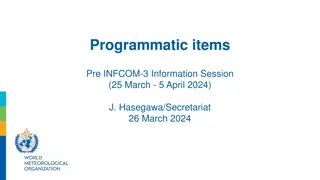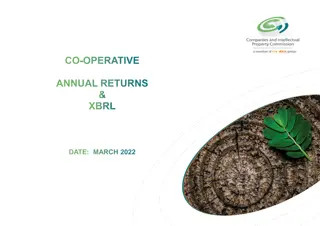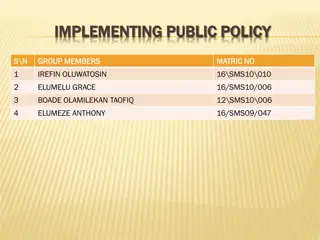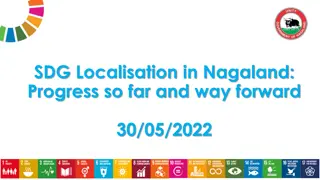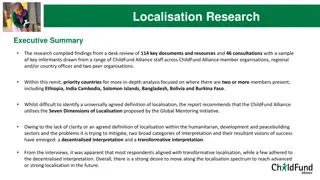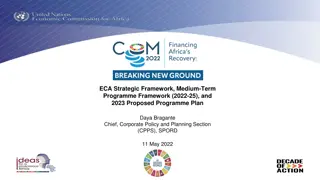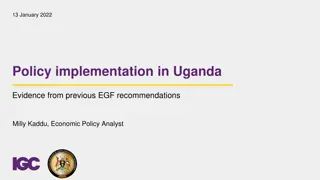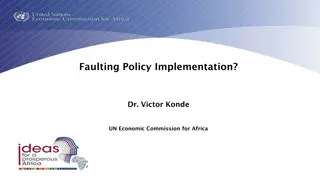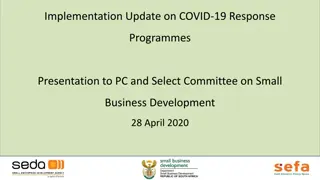SMME-Focused Localisation Policy Framework and Implementation Programme - Overview
Cabinet decision to adopt localisation for industrialisation in South Africa led to the development of a policy focusing on SMMEs. The policy aims to build manufacturing capacity, support import replacement, enhance private sector involvement, and utilize public procurement to drive localisation. The presentation outlines the objectives, goals, risks, and mitigation strategies for implementing the localisation policy.
Download Presentation

Please find below an Image/Link to download the presentation.
The content on the website is provided AS IS for your information and personal use only. It may not be sold, licensed, or shared on other websites without obtaining consent from the author.If you encounter any issues during the download, it is possible that the publisher has removed the file from their server.
You are allowed to download the files provided on this website for personal or commercial use, subject to the condition that they are used lawfully. All files are the property of their respective owners.
The content on the website is provided AS IS for your information and personal use only. It may not be sold, licensed, or shared on other websites without obtaining consent from the author.
E N D
Presentation Transcript
SMME-FOCUSED LOCALISATION POLICY FRAMEWORK AND IMPLEMENTATION PROGRAMME 18 NOVEMBER 2020 VER 14 1
PRESENTATION OUTLINE ANNEXURES: PROPOSED LOCALISATION PRODUCTS, PHASES AND MARKETS (attached as Excel Workbook) 1. INTRODUCTION 2. CONTEXT 2.1 The China Experience 2.2 The Central and Eastern Europe Experience 2.3 Lessons from Apartheid South Africa Annexure A: Annexure B: Annexure C: Annexure C-1: Annexure D: Annexure E: Annexure F: DTIC Designated Products and categorisation Proposed Products for Phase 1 Implementation Proposed Set-Aside Products and Services for Public Sector Procurement (phased implementation plan needed) 3. OBJECTIVES 4. GOALS 2018/19 Government Expenditure on Goods & Services Categorised 5. BUILDING MANUFACTURING CAPACITY 5.1 Objectives of the Manufacturing Support Scheme 5.2 Three-Category Focus of the Manufacturing Support Scheme (MSS) 5.3 Nature of Support Under the MSS 5.5 Business Development Support under the MSS 5.6 Financial Support under the MSS Proposed Products for Phase 2 Implementation Proposed Products for Phase 3 Implementation Products with potential for SA SMMEs to export to rest of Africa & other international markets 6. COORDINATED IMPORT REPLACEMENT PLAN 6.1 The 3-phase Route from Assembling to Full Manufacturing Capacity 6.2 Categories of Products with Existing Local Production Capacity by SMMEs 6.3 Proposed Products for Additional Designation 6.4 Proposed Incentives for Import Replacement Annexure G: Annexure H: Products and Trade Markets Framework Products for potential imports from rest of Africa 7. FRAMEWORK FOR PRIVATE SECTOR SUPPORT TO SMME PARTICIPATION 8. PUBLIC PROCUREMENT CONTRIBUTION TO LOCALISATION 9. RELATED/ ENABLING SERVICES 10. KEY RISKS OF IMPORT REPLACEMENT STRATEGY 11. MITIGATION AGAINST THE IDENTIFIED RISKS 12. NEXT STEPS 13. RECOMMENDATIONS / CONCLUSIONS 2
1. INTRODUCTION Many countries followed a localisation approach to industrialisation as part of accelerating their economic development. From an analysis of the localisation trends in various countries, the following conclusions can be made: It can be argued that localisation is the foundation phase for building capacity for a future export-led economy, as the home market mitigates the risk against low product demand; The countries that have succeeded with localisation have relied on access to larger markets and the AcFTA creates a larger market for South African products; Localisation is effective with some form of domestic industries protection. 3
2. CONTEXT Cabinet took a decision to adopt an approach of industrialisation through localisation to rebuild the production economy, create jobs and transform the ownership patterns of the South African economy to become inclusive. SMMEs are the largest number of businesses in South Africa, estimated to range between 2.4 million and 3.5 million, with the largest number in the informal and micro level of business activity. Given the size and reach of SMMEs in South Africa, and their meaningful participation in the economy, particularly in the production economy , there is a need to expand the extent of the participation of the previously disadvantaged enterprises in the mainstream of the economy. The Department of Small Business Development (DSBD) was assigned the responsibility to develop and propose a localisation policy in the 2019 2024 Medium Term Strategic Framework (MTSF). The approach DSBD adopted is to develop an SMME-focused localisation policy framework for South Africa. 4
2.1 The China Experience China compressed Western and Japanese centuries of development into 3 decades, moving from being a relatively poor country in the late 1970s to a second-largest economy in the world to date; Their localisation programme was anchored in the participation and acceleration of rural enterprises in large numbers (millions of rural enterprises); The first phase focused on the production of labour intensive light consumer goods using imported inputs, whilst the second phase involved mass production of the means of production, e.g. steel, cement, chemical fibres, ships, highways, bridges, machine tools, etc; It must be noted that China commenced its export drive, parallel to their localisation programme The Industrialisation policy of China is also seen as a means to become an international leader in innovation and technology in the future. 5
2.1 The China Experience (cont.) Financial support for and investment in Research and Development (R&D) by both government and business and promotion of autonomous research institutions; Fostering innovation by supporting public and private institutions in the technology sector; Increased trade in manufactured goods instead of natural resources; Promoted rural industries despite their undeveloped technologies Progressed from light to heavy industries, from labour to capital intensive production, from manufacturing to financial capitalism; and Graduating China from factory of the world and position it as the research laboratory of the world and not solely based on government programmes. 6
2.2 The Central and Eastern Europe Experience Examined 8 countries: o Higher-income: Czech Republic, Slovenia, Slovakia and Lithuania; o Middle-income: Hungary and Poland; and o Lower-income: Bulgaria and Romania. Post the collapse of the Soviet Bloc and greater trade openness, these countries could not bear competitive pressures brought by the fast growth in the inflow of Foreign Direct Investments (FDIs) and foreign products (imports); Between 1992 and 1995 more than 1,3 million jobs were lost in manufacturing in these countries; A re-industrialisation drive focused on growth: o in absolute and relative contribution of manufacturing to GDP, o manufacturing employment, o changes in the structure of manufacturing sector towards more high-tech manufacturing; o relatively high growth in labour productivity; o in exports of manufactured goods; and o Drive towards digitisation, technology diffusion into industry, and digital skills development NB: de-industrialisation continued in Romania 7
2.3 Lessons from Apartheid South Africa Apartheid South Africa s industrialisation path did not reach its full potential as there was no mass production on manufactured goods and its benefits accrued to only one racial group; In the early 1920s , poor white Afrikaner workers protested the British dominance of big industry, mainly mining, and the rise of skilled black labourers; State paid for huge public works programmes to make jobs for white people. e.g. Hartbeespoort Dam project hired 3400, and other unskilled white labourers were hired in Iscor and other state-owned entities The state increased state budgets for subsidies to white farmers thus laying the foundation for the exponential rise of commercial farming by Afrikaners, who were also protected through the Customs Tariff Act by placing high tariffs on imported agricultural-related products; The establishment of the Industrial Development Corporation in 1940 was seen a project of creating an institution of high- speed growth in promoting industrial development. The textile industry was pioneered by the IDC in areas with high rural population such as in King Williams Town (the Good Hope Textile Corporation) in Uitenhage (Fine Wool Products), other textile factories were set up in other parts of the country followed by the growing of cotton in Northern Zululand (now KZN) and Eastern Transvaal (now Mpumalanga); South Africa shifted to light goods manufacturing by manufacturing packaging materials, milk-powder and breakfast foods, footwear and wearing apparel, domestic baths and glazed wall tiles, truck and bus bodies, plastic switches and electric fittings, and livestock remedies and insecticides. 8
2.3 Lessons from Apartheid South Africa (cont.) By 1947, the economy had diversified such that manufacturing industry contributed 22.5% to GDP, agriculture at 14.5%, trade and commerce at 14.5%, transportation at 9.5% and gold mining at 8%. This economic structure was propelled by the IDC s involvement in deepening the industrial base. The State introduced high tariffs on imports so that local industries could compete. State-run companies like Eskom, Sasol and Iscor (today ArcelorMittal) benefitted, and prioritised the hiring of white people. Two major national strategic projects were established by the IDC during the 1950s, the South African Coal, Oil and Gas Corporation (Sasol) and the Phosphate Development Corporation (Foskor). 9
3. OBJECTIVES To provide a framework for increasing and accelerating participation of SMMEs in the localisation programme, in particular for rural and township based manufacturing enterprises; To target specific products/ services and support production or manufacturing by SMMEs, and advocate for the high tariff protection and public sector procurement set asides or reservations for such products; To use the localisation programme to prepare SMME-manufactured products for the export market and improve the balance of trade for South Africa; To stimulate domestic demand for South African manufactured goods (SMME-produced), in particular through public sector procurement; To foster changes in the structure of the manufacturing sector towards more high tech manufacturing; and To provide a framework for coordinating public and private sector support for SMME participation in the localisation programme. 10
4. GOALS 1. Building manufacturing capacity of SMMEs; 2. Coordinated Import Replacement Plan for SMMEs; 3. Establish a route to market framework for SMME manufactured products; 4. Preparation and support for SMME towards export market penetration; 5. Service localisation to allow development of skills; 6. Support SMMEs to adopt innovation and digitisation; and 7. Establish a funding framework for the localisation programme 11
5. BUILDING MANUFACTURING CAPACITY Implement a focused manufacturing programme to build and support SMME participation in the manufacturing value chain for purposes of localisation based on the following principles: Accelerate township and rural enterprises in the manufacturing value chain; Intensify SMME participation in the light and fast consumer goods manufacturing; Facilitate the participation of SMMEs in the high-demand minerals beneficiation, e.g chrome and ferrochrome; and Revitalisation of dormant industrial production infrastructure Prioritised focus areas for the Manufacturing programme: Food and beverages industry including agro-processing for purposes of food security; Furniture and general use products; Pharmaceuticals and nutraceuticals for purposes of self dependence and health interests of the continent; Clothing, leather and textile sector is already designed for 100% local content Beauty and personal care products Pulp and paper products Petroleum and chemical products; and Plastic and plastic products 12
5. BUILDING MANUFACTURING CAPACITY (cont.) Build towards improved SMME participation in the following heavy industry manufacturing: Components manufacturing with an ultimate aim of supplying components to the automotive sector; Construction equipment manufacturing; and Steel manufacturing in support of the Chrome and Ferrochrome Strategy of DMRE; Thus the plan is to target 12 manufacturing sub-sectors for focused support; As part of Phase 1, implementation of the Manufacturing Support Scheme is underway for the formal SME; An additional Clothing, Leather and Textile scheme is under implementation to support informal and micro businesses; NB: General Use Products include: Kitchen and dinning products; Cleaning and storage products; Gardening and entertainment products: Household electric products Black equipment including spade, digging fork, garden rake etc; Baby goods including toys; Clock, watch and eyewear; Household sundries; and packaging materials 13
5. BUILDING MANUFACTURING CAPACITY (cont.) One of the 12 manufacturing sub-sectors focuses on green and digital technologies. A key focus of this policy framework is to support one of the programmes of the green economy which is clean energy and energy efficiency. Under this programme, the focus will be on the off-grid options in rural and townships, optimisation for large scale renewable and the upscaling of the Solar Water Heater programme. Opportunities in this area include: Development of mini-grids by SMMEs and Co-operatives Wind energy (blade and tower) manufacturing Local PV panel manufacturing Local battery manufacturing Solar energy water heaters manufacturing 14
5.1 Objectives of the Manufacturing Support Scheme Increase relative contribution of SMMEs in the manufacturing sector by 2030; Increase the manufacturing employment targets through SMME production; Increase exports of manufactured goods through SMME production with focus on dedication niche; Increase/ grow labour productivity and competitiveness in the manufacturing sector for SMMEs; and Change the structure of manufacturing to high tech; 15
5.2 Three-Category Focus for the Manufacturing Support Scheme 1. LIGHT CONSUMER GOODS (a) Food and Beverages/ agro- processing (b) Pharmaceuticals and nutraceuticals (c) Beauty and personal care products (d) Plastic and plastic products (e) Certain Pulp and paper products (e.g toilet paper) (f) Clothing and textile 2. REVITALIZE INDUSTRIAL PRODUCTION 3. HIGH-TECH MANUFACTURING (a) Basic iron and steel (a) Electrical machinery (b) Green and digital technologies (dependent on strong and fast R&D output) (c) Components manufacturing; (d) Construction equipment manufacturing (b) Petroleum and chemical products (c) Furniture & general use products (d) Pulp and paper products NB: government commitment to aggressively fund research and development, and government as the early or first technologies as part of creating necessary markets for the technologies or innovations; 2. Full list of 1000 products targeted for manufacturing by SMMEs; 3. It must be noted that funding is not limited to the 1000 listed products but other products may be considered if they fall within the 3 listed categories. 1. Green and digital technologies sectors not included in the Manufacturing Support Scheme focus as there is no clarity on adopter of novel 16
5.3 Nature of Support under the Manufacturing Scheme Provide financial and non-financial support to small enterprises in the manufacturing industry sub-sectors: a) Provide business infrastructure support to small enterprises; b) Facilitate route to market in both the domestic public and private sectors and export markets; c) Facilitate aggregate input costs for raw materials; d) Technical skills, product certification, testing and quality assurance; and e) Financial assistance (loans blended funding) 17
5.4 Business Development Support under MSS 1. Technical Skills Support a. Specialised business management training through Seda and other incubators, where necessary b. Certification of products via SABS, SAHPRA, Medical Controls Council and other Standards bodies c. Technical skills training in collaboration with the Chemical Industries Education and Training Authority (CHIETA) for manufacturers of chemicals and related products, MERSETA for engineering skills and other relevant SETAs. d. SANAS, NRCS, SABS to provide access to Lab Testing for the accreditation and certification of chemical and related products. e. Tax education training relating to incentives that supports localisation. 18
5.4 Business Development Support (cont.) 2. Business Infrastructure support (buildings and machinery) a. Factory space in industrial parks small enterprises; b. Need for DTIC to ensure DTIC-owned/ funded industrial parks (under refurbishment) prioritizes SMMEs participating in the localization programme; c. Refurbish unused government buildings and fit with machinery for small enterprises to rent; d. Fund acquisition of processing and manufacturing facilities including machinery and equipment. 19
5.4 Business Development Support (cont.) 3. Route to Market a. Facilitate government departments and state-owned enterprises procurement from the supported producers, including public institutions such as courts, correctional centres, schools, hospitals, police stations, libraries, etc. b. Enforce the Local Procurement Accord commitment on private sector procurement from the supported producers c. Steel/metal work enterprises to participate in government infrastructure programme including the low-cost housing, schools, health facilities d. Facilitate access to retail shelves including in wholesalers, spazashops, large retailers and facilitate products trade markets and shared stores in townships and rural areas. e. Facilitate access to exports markets through partnerships with International Trade Centre, European Union, and Africa Continental Free Trade Agreement f. Actively promote the #BuyLocalBuyMadeInSA campaign 20
5.5 Financial Support Under the MSS 1 Financial support a. Funding to acquire industrial facilities including machinery and equipment for the various manufacturing sub-sectors that will be supported. b. Working capital for the prioritised manufacturing sub-sectors will be supported. c. Funding for product accreditation, certification and testing. 1.1 Funding terms a. b. Funding of up to a maximum of R15 million per small enterprise. The term of the funding will be determined by the business cash flows up to a maximum of 84 months per small enterprise with a maximum moratorium of 8 months. Blended finance instrument will be utilised where up to 50% of the funding required could be a grant (soft loans) and the balance could be a loan based on developmental needs. Job creation potential with ability to create at least 10 jobs The loan will be repayable at prime lending rate. c. d. e. 21
6. COORDINATED IMPORT REPLACEMENT PLAN Reduce import dependence through: Implementation of focused industry sectors localization projects; The 3-phase route path from assembly to full local manufacturing capacity (high-tech manufacturing category); Products with existing local production capacity by SMMEs (light consumer goods and revitalize industrial production categories); and Proposed Incentives programme Industry Sectors Localization Projects 12 industry sectors identified for the manufacturing scheme with an additional green and digital technologies sectors dependent on SA s approach to research &development, and digitization; Proposed products for the localization identified with inputs from large retailers and lessons learnt from spazashops as alternative markets and consulted with other government departments and agencies including SARS; Engagement with DTIC on the revision of the Designated Products List is underway; and Engagement with National Treasury on the revision or development of tax incentives for the localisation policy. 22
6.1 The 3-phase route from assembly to full local manufacturing capacity Phase 1: 40% - 60% LOCALLY ASSEMBLED WITH 40% LOCAL CONTENT Phase 0: 100% COMPLETED PRODUCT IMPORTS (Based on Currently Designated Phase 2: 60% - 100% LOCALLY ASSEMBLED WITH 60% LOCAL CONTENT (a) (b) Household sundries (c) Construction equipment (d) Gardening and entertainment products (e) Foodstuff (f) Household electrical products Clock, watch and eyewear Plastic and plastic products (a) Electrical machinery (b) Household electric appliances (c) Pharmaceuticals (d) Steel (e) Green and digital technologies (a) Electrical machinery (b) Components (automotive and heavy machinery) (c) Pharmaceuticals (d) Steel (e) Green and digital technologies (g) Phase 3: 100% LOCALLY ASSEMBLED WITH 100% LOCAL CONTENT (a) Household electric appliances (b) Household sundries (c) Clock, watch and eyewear (d) Light electrical machinery (e) Baby goods (f) Gardening and entertainment (g) Plastic and plastic products NB: Phase 3: Must be based on increased utilization of research, innovation and digital technologies 23
6.2 Categories of Products with existing local production capacity by SMMEs (a) Pulp and paper products (NB. Product testing and quality assurance) Note: Match Against List of Product Requirements of Suppliers and Retailers and level of product certification (b) Packaging products except plastic (c) Nutraceuticals (d) Beauty and personal care products (e) Clothing, leather and textiles (f) Food and beverages (g) Furniture (h) Chemical products (i) Cleaning and storage products (NB. Product testing and standardisation) (j) Soft furnishings including crafts 24
6.3 Proposed Products for Additional Designation Listed of currently designated products that are relevant for SMME participation: Annexure A Only 12products relevant for SMME participation out of 27 designated products; Current designated products does not support mass participation of SMMEs in townships and rural areas as few products in areas of SMME production capacity are not designated, e.g. few the fast consumer goods category barely made the list; Current designated products does not contribute to the building of self sufficiency with regard to critical elements of as food security List of proposed additional products for designation attached as Annexes B, C, D & E Propose a 4-year timetable for designation (Annexes B - E) to allow the building of SMME production capacity and the necessary capacity assessment; Principles applied for recommending products for designation: Existence of or opportunity to build local production capacity within the SMME sector, in particular with mass participation potential; Local availability of ingredients where local includes the African continent; Need for national self sufficiency such as food security; Constrains posed by possible disruptions to international supplies; Possible building of adequate supplies for domestic market to allow full prohibition of imports to minimize administrative burden for customs; and Products that can be exported to key markets including the AcFTA 25
6.4 Proposed Incentives for Import Replacement Advocate for the protection of domestic companies, in specific manufactured goods; Implement high import duties, e.g Russia is currently applying this incentive; Implement outright exclusion of certain products from being imported into South Africa; Implement cost subsidies for production of certain categories of products, including preferential electricity tariff application for production sectors/ industries; Implement high export tariffs for raw materials that are ingredients of designated localization products; Support the DMRE driven consultation on the export tax on Chrome and Ferrochrome Regulations through National Treasury in consultation with DSBD to: Exclusion of from public sector procurement of certain categories of products made outside South Africa or not meeting local content requirements; Reserve certain categories of products produced by SMMEs for public procurement (Annexure C); NB: Exempt African countries in line with the provisions of the AcFTA agreements. 26
7. FRAMEWORK FOR PRIVATE SECTOR SUPPORT TO SMME PARTICIPATION Private sector has funding capability through their enterprise and supplier development programme (ESDP); A coordinated and consolidated implementation of the localisation programme between government and the private sector can result in optimal and impactful utilisation of the ESDP funds and manufacturing support funds to achieve the localisation targets; The DSBD is finalising collaborated implementation plan with major retailers including wholesalers and larger suppliers in the FMCG sector through their ESDP and other SMME support initiatives; The planned Implementation Plan will cover agreement on: Products for import replacement the products are already agreed to; Products quality standards and applicable certification processes: Designated budgets for localisation initiatives; Route to market plan including access to export market; Implementation milestones and progress evaluation mechanism; and Institutional arrangements between the DSBD, its agencies and the large suppliers. Related services businesses must be designated to strengthen local capacity and self-reliance There will be no point in planning to build industrial capacity without some level of self-reliance on concomitant services The designation of services must prioritise service areas where significant transformation has been made. 27
8. PUBLIC PROCUREMENTCONTRIBUTION TO LOCALISATION Public sector remains the largest consumer of goods and services, therefor the promotion of localisation through public procurement is paramount; National Treasury reports that government spent over R800 billion on goods and services alone in 2018/ 2019 financial year, and this excludes expenditure from State Owned Entities, and municipalities; Public Sector expenditure must be used to drive SMME including cooperatives participation in the localisation programme through set asides as following: Designation of specific goods and services for procurement solely from SMMEs (Annexure C); Priority must be given to goods made in South Africa especially those produced by SMMEs; The designation of products and services for public sector procurement must also include a provincial designation to enhance local economic development; The provincial designation must be drawn from the national pool to allow development on South Africa niche on particular products as this will also form part of building for export capacity; and The choice of goods for designation must be in line with advancing the set objectives and goals of the localisation programme. 28
9. TOWNSHIP & RURAL ENTERPRISES AND INFORMAL BUSINESS AS CRITICAL ROUTE TO MARKET FOR LOCALIZATION (SMME products) Given the size of the market that is serviced by township/ rural and informal/ micro businesses, if well coordinated these enterprises can serve as critical route to market for other SMMEs producers and services DSBD commenced a programme to avail critical market access to emerging producers as they prepare to replace imports in South Africa and grow trade with the rest of the African continent DSBD lists SMME products with participating wholesalers for sale through Spazas, general dealers and auto spares Further, DSBD has commenced listing of SMME products with retailers In addition, DSBD is working to establish products and trade markets in townships and rural towns to serve as markets for SMME products. The first pop- up markets will be operational by December 2020 29
9.1 PRODUCTS FOR LOCALISATION THROUGH SPAZA SUPPORT AND LISTED IN WHOLESALERS A basket of goods products most often purchased by spaza shops that are used to support SMME manufacturing (48 products). To date 78 SMME brands on this basket are being listed with wholesalers. 30
9.1 (A) EXAMPLES OF SMME BRANDS LISTED IN WHOLESALERS Product Brands Contact person Wholesaler Number of jobs Midi Tea Fhumulani Magidi Premjee & Sons 305 TM foods Sliced beetroot Tryphina Mosomane Premjee & Sons 15 Milk Pure Body lotion Thembani Nghalaluma Devland 2 Lindiwe Sanitary towels Lindiwe Nkuna Devland 14 Glochem Liquid soap Mmoni Sehlapelo Devland 1 Marula Body lotion Portia Mngomezulu Devland 95 Enpro Household cleaner Andy Matakanye Devland 5 Monate Spice Atchaar Pitso Mototo BIBI 6 Perfect Dry beans Katleho Motsoasele BIBI 8 Phepisa Hand sanitiser Phephsile Maseko Goldfields 3 Silvastar Biscuits Sylvester Kgotso Serage Numain & Sammys (NC) 5 HQ Foods Spices, Sauces, Garlic and Atchaar Ebrahim Adams One-up Cash and Carry 55 31
9.2 PRODUCTS FOR LOCALISATION AND LISTED IN RETAILERS (cont.) 33
Company Profiles Company Profiles 34
NILOTIQA 35
LA ROSA 37
10. RELATED/ ENABLING SERVICES The success of any coordinated programme that supports SMMEs requires the consolidation of a single database for SMMEs in the country that will serve as a single source of data about SMMEs; The DSBD is successfully mobilizing private sector to integrate their ESDP platforms with the SMME SA for improved synchronization of SMME support data and sharing of opportunities; It is agreed that SMMEs that will participate in the localisation programme with the support of the DSBD and major FMCG will have to register in the SMME SA on https://smmesa.gov.za, irrespective of whether they enter the programme through the DSBD or the FMCG companies; The registration of participating SMMEs will assist in improving traceability and measuring impact of the programme; Need to lobby the AU to convert the Africa s Medical Supplies Platform to become Africa s products platform to encourage intra-continental trade through the platform; and integrate the SMME SA with the platform; and Currently working with the EU to integrate the SMME SA at trade exchange level to the EU trade platform with agreement for future integration with the International Trade Centre platform. 39
11. KEY RISKS OF IMPORT REPLACEMENT STRATEGY The following risks have been identified as key as they may derail the implementation: a. Price increases of goods that could be sourced cheaper from external markets due to production efficiencies; b. Drop in quality of products before the local producers adjust to the requisite quality standards; c. Lack of markets for products; d. Localisation programmes can promote distortion of national and international competitiveness; e. Foreign governments are less willing to accept distortions of competition; and f. Tax as a barrier to entry or unavailability of tax incentives to support this initiative. 40
12. MITIGATION AGAINST THE IDENTIFIED RISKS a. The technical support offered by the DSBD and its agencies include support with production optimization and efficiencies to make products competitive even price wise; The DSBD through SEDA have established partnerships with the SABS, the SA Health Products Regulatory Authority (SAHPRA), other standard bodies and currently facilitating a partnership with the Medical Controls Council aimed at effectively supporting SMMEs with compliances with quality and standards requirements; The partnership between the Department and the private sector entails commitments on shelve space. In addition, the Department is also utilizing spazashops and general dealers, beauty salons, panel beaters, motor mechanics and autospares shops as alternative routes to market for products manufactured by SMMEs; The localization programme is matched with the export market support programme and therefore competitiveness remains a key component of SMME production; and The Covid-19 experience have demonstrated to governments the need for self sufficiency, and the SA export programme is linked to an import improvement programme for African countries in line with AcFTA provisions; and Use of the SMME SA database to minimise possibilities of abuse by non-players b. c. d. e. f. 41
13. NEXT STEPS Stakeholders and key partners have been consulted on the Draft Localisation Policy Framework with buy-in from key departments and agencies; Finalise Implementation Plan in consultation with key partners; The Implementation Plan amongst others cover: Registration of SMMEs on the SMME SA database according to the products they produce with an indication of their certification; A mechanism to assist with product certification process (fast-track): Mechanisms for other technical assistance required such as production efficiency improvement; Process to place products on shelves of big retailers; Plan to create alternative markets for SMME manufactured products, in addition to Spazashops, hair salons and public procurement Mechanism of initiating product development where there is market potential/ demand without local suppliers; Improved mechanism of coordinating product clusters (initially undertaken by DTIC) and cooperatives Post-investment support; Progress monitoring and evaluation Institutional arrangements encompassing the private sector Set-up the multi-disciplinary portfolio team (internal to department); inter-departmental team (internal to government) and multi-sectoral team (involving large suppliers and retailers) to drive the implementation; 42
14. RECOMMENDATIONS/ CONCLUSIONS SA s localisation programme must be implemented parallel to a robust export drive, in particular into the AcFTA; SA must finalise its approach to Research and Development both in terms of improved funding, output turnaround time, and a mechanism of supporting SMMEs by research institutions without charging excessive fees. This is critical for driving innovation and shifting to high tech manufacturing: The localisation programme must: prioritise township and rural based enterprises as part of building an inclusive economy; Drive high employment targets; Focus on the 12 manufacturing sub-sectors; and Utilise set-asides and reservations through public sector procurement Once adopted, both the government and big business must commit to coordinated funding approach and other contributions towards successful implementation: Government must institute clear and reasonable protection measures for local industries; Large suppliers and retailers must commit shelve spaces in a manner that predictable and affordable to SMMEs; Product designation must also include FMCG products as they will have direct impact on the consumption patterns of South Africa; Import Replacement Plan must accommodate transition from assembly based to full manufacturing and the building of local capacity and the phased designation timetable allows for this transition; Localisation drive through beneficiation in the mining sector (chrome and ferrochrome) and heavy electricity consumption sectors would require a government decision on managed electricity prices for such industries based on the economic benefits for the country; and Public sector procurement must be used to promote localisation with specific set asides and reservations (as proposed) for SMMEs including cooperatives. 43
/End. Ro livhuwa 44
ANNEXURES: PROPOSED LOCALISATION PRODUCTS, PHASES AND MARKETS (EXCEL WORKBOOK) Annexure A: DTIC Designated Products and categorization Annexure B: Proposed Products for Phase 1 Implementation Annexure C: Proposed Set-Aside Products and Services for Public Sector Procurement Annexure C-1: 2018/19 Govt Expenditure on Goods & Services Categorized Annexure D: Proposed Products for Phase 2 Implementation Annexure E: Proposed Products for Phase 3 Implementation Annexure F: Products with potential for SA SMMEs to export to rest of Afrika & other international markets Annexure G: Products for potential imports from rest of Afrika Annexure H: Products & Trade Markets Framework 45



